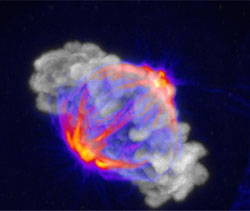Of Yeast and Men: An evolutionary tale

Dividing human cancer cell in Metaphase. The DNA (gray) is attached to the spindle apparatus (pseudocolored). Copyright: IMP/Ladurner<br>
The adult human body consists of trillions of cells. Cell proliferation is accomplished by means of cell division in which an existing cell serves as the exact blueprint for its progeny. This process follows the same basic principles in all higher organisms. First, the genetic information is precisely copied and subsequently equally distributed between the mother and daughter.
The major task for the dividing cell is to drag two complete sets of chromosomes to the opposite sides of the nucleus, respectively. A logistic challenge accomplished by the interplay of two factors: the spindle apparatus that acts as the molecular motor driving chromosome movements, and the kinetochore that constitutes the physical platform between the DNA and the mitotic spindle.
The attachment site formed by the kinetochore is an intricate protein network. While its components providing the direct contact point for the spindle are very well preserved from yeast to human, evolution of the DNA-binding proteins remained puzzling given that the underlying DNA template is highly variable.
Now, a novel study published in the June edition of Nature Cell Biology sheds light onto the cryptic molecular relationship between the yeast and human kinetochore. Principal investigator Stefan Westermann and his team tracked the missing evolutionary link and opened up new insights into the architecture and function of the key division organelle.
The correct shape pieces the puzzle together
“The clue was to take a close look at the protein sequence as well as specific sequence motifs that get an amino acid chain into its particular shape.” says Stefan Westermann. “In this way, our bioinformatician Alexander Schleiffer was able to predict a number of novel DNA-binding kinetochore proteins and assigned them to the respective human homolog.” Follow-up experiments strongly supported analogous function of the proteins. “Yeast is still an informative model organism and very easy to handle. Our current findings can now direct similar studies in more complex systems. There erroneous chromosome segregation is deleterious for the cell and a common cause of cancer” explains the scientist.
Pull chromosomes together
One of the novel proteins, termed Cnn1, turns out to be of special interest. It connects to the kinetochore molecule Ndc80 that is the major contact point for the spindle apparatus. “This particular interaction is not essential for the initial attachment of the spindle. It rather plays a supporting role that timely overlaps with maximal pulling forces acting on the chromosomes” says Stefan Westermann.
ENDS
The paper “CENP-T proteins are conserved centromere receptors of the Ndc80 complex” by Schleiffer et al. will be published online on Nature Cell Biology's website on 06 May, 2012 (DOI 10.1038/ncb2493).
About the IMP
The IMP is a basic research institute in Vienna, Austria. Its main sponsor is Boehringer Ingelheim International, headquartered in Germany. With over 220 employees from more than 30 different nations, the IMP is a Center of Excellence in the life sciences and the core unit of the Campus Vienna Biocenter. Research at the IMP aims at elucidating the molecular basis of normal development and disease.
Contact:
Dr. Heidemarie Hurtl
IMP Communications
Tel. +43 1 79730-3625
mobile: +43 (0)664 8247910
hurtl@imp.ac.at
Scientific Contact:
Dr. Stefan Westermann
westermann@imp.ac.at
Media Contact
More Information:
http://www.imp.ac.atAll latest news from the category: Life Sciences and Chemistry
Articles and reports from the Life Sciences and chemistry area deal with applied and basic research into modern biology, chemistry and human medicine.
Valuable information can be found on a range of life sciences fields including bacteriology, biochemistry, bionics, bioinformatics, biophysics, biotechnology, genetics, geobotany, human biology, marine biology, microbiology, molecular biology, cellular biology, zoology, bioinorganic chemistry, microchemistry and environmental chemistry.
Newest articles

NASA: Mystery of life’s handedness deepens
The mystery of why life uses molecules with specific orientations has deepened with a NASA-funded discovery that RNA — a key molecule thought to have potentially held the instructions for…

What are the effects of historic lithium mining on water quality?
Study reveals low levels of common contaminants but high levels of other elements in waters associated with an abandoned lithium mine. Lithium ore and mining waste from a historic lithium…

Quantum-inspired design boosts efficiency of heat-to-electricity conversion
Rice engineers take unconventional route to improving thermophotovoltaic systems. Researchers at Rice University have found a new way to improve a key element of thermophotovoltaic (TPV) systems, which convert heat…



